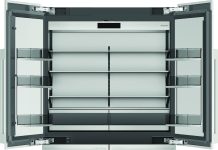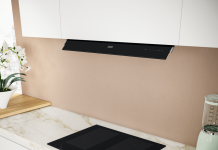Synchronous Reluctance Motors could be a valid alternative to the traditional motors and present many advantages that concern the simple, rugged rotor core, no permanent magnets, no rotor cage and consequently no copper losses. Therefore, in addition to industrial applications, it can be a good solution for the fractional power applications, and this paper presents the design of a three-phase, 200 W Synchronous Reluctance motor for household appliances.
The Synchronous Reluctance Motors (SRMs) are increasingly being interest of research subject and they could replace the induction motors and permanent magnet motors in variable speed applications. The SRMs present many advantages that concern the simple, rugged rotor core, no permanent magnets, no rotor cage and consequently no copper losses which makes it a simple and robust electric motor and can be constructed entirely from high-strength, low-cost materials.
In recent years many efforts have been done to replace permanent magnet motors used in different applications, and also in the home appliances, because of remarkable increase in the rare earth permanent magnets costs.
Fractional power motors in home appliances consume notable part of produced electrical energy and increase in these motors efficiency can reduce significantly the energy consumption. The SRM could be an important candidate for use in home appliances for their lower cost than permanent magnet motors, comfortable mass production and acceptable energy efficiency level.
The stator is like the induction motor one and the rotor presents a transversally laminated anisotropy structure that produces good torque level. The torque depends on saliency ratio which is the ratio of motor d-axis to q-axis inductances.
The design of this type of motor requires a fine analysis and an accurate prediction of machine parameters and performances. That is very difficult because of its highly saturated operating conditions and its salient structure. The use of linear models in evaluating the performances can lead to serious errors since the SRM presents notable non-linear characteristics due to the effects of the saturation and cross-coupling phenomena occurring in the magnetic circuits. These phenomena can be taken into account by an accurate non-linear analysis which can be performed by Finite Element (FE) software.
In this paper, the design and analysis of a three-phase 200 W, 3000 rpm Synchronous Reluctance Motors is presented for household appliances (e.g. vacuum cleaners, hoods).
The design process
The rotor of the investigated motor is a laminated rotor with flux barriers (without webs) that can be manufactured with normal punching tools at very low cost; the number of barriers varies from 2 to 5 and depends on the number of pole pair and stator slots. The stator core is similar to the conventional induction motor one. The typical cross section of the SRM is shown in Fig. 1.
Since the stator winding of the SRM is sinusoidally distributed, flux harmonics in the air gap contribute only an additional term to the stator leakage inductance. Hence, the equations that describe the behaviour of the synchronous reluctance machine can be derived from the conventional Park’s equations for a wound field synchronous machine.
The torque in the rotor reference frame is:
where Ld and Lq are, respectively, the direct and quadrature axis inductances, p is the number of pole pairs and Id and Iq the direct and quadrature axis currents.
The motor is controlled according to the vector control theory and to obtain maximum performance from variable speed drive it is necessary to adopt suitable control strategy. According to consolidated literature, the optimization criteria for the SRM refer to “Maximum Torque per Ampere” strategy.
The torque produced by the SRM is due to the anisotropy of the rotor (different d and q axis inductances Ld and Lq) that causes an angular displacement between the space vectors of stator linkage flux and current. In the SRM, both Ld and Lq vary with saturation, and the d-axis inductance is more sensitive to saturation than the q-axis inductance due to the low reluctance path of d-axis flux.
The main advantages of SRMs with multi-barriers rotor structures are:
• no winding and PM in the rotor (“cold” rotor);
• low inertia;
• good acceleration performance;
• good flux weakening operation;
• low manufacturing cost.
On the other hand, SRMs exhibit some drawback such as high torque ripple that is mainly due to the discontinuity reluctance change between stator and rotor which can produce vibration and noise. It can be drastically reduced by a fine design of the rotor and stator shape, an accurate selection of the set of rotor barriers and stator slots numbers or by means of the rotor skewing.
The design of these type of motors requires a fine analysis and the prediction of machine parameters and performances. For this reason, a design procedure has been carried out using a Finite Element tool in order to take into account the cross magnetization and saturation effects.
Starting from the main motor requirements, the geometric dimensions of the stator and rotor core are determined by a sizing procedure and then the motor performance are evaluated by FE software. The convergence on the rated torque is achieved by a suitable optimization algorithm.
The structure of software for the motor design is shown in Fig. 2 and includes two main steps: preliminary design and design refinement.
In the sizing procedure, the motor dimensions and any other geometrical data are determined by adopting simplified relationships between geometrical and physical motor data to meet the motor specifications.
In order to accelerate the convergence on torque, that represents the main motor specification, an optimization algorithm has been introduced that allows to vary the geometric dimensions of the preliminary design step. The algorithm has been interfaced with the FE analysis procedure and has been integrated in the design refinement process and represents a useful tool for a fast and efficacious fulfillment of motor requirements.
The independent variables concerned the stator and rotor shapes and the stator winding (Fig. 3). In addition, the following constraints have been considered: phase voltage, that is related to the maximum voltage of inverter, flux densities in the stator teeth and yoke, torque ripple and slot fullness.
A case study
The proposed procedure has been used for the design of a three-phase fractional power 200 W, 3000 rpm, 4-pole Synchronous Reluctance motors for household appliance (e.g., vacuum cleaners, hoods).
The motor is integrated with the drive fed by 230 V single-phase voltage. This integration gives good benefit, and the motor-drive structure combines both the motor and its associated control and drive circuitry within a single enclosure.
The main motor requirements and constraints are listed in Table 1. The motor is air cooling (natural, no forced air) and the housing encumbrance has been imposed. Moreover, the commercial SiFe M800-50A electrical steel has been selected, 0.50 mm thickness.
The sizing procedure has allowed to optimize the SRM design and Fig. 4 shows the cross section of the motor and the shape of the flux barriers. The iron bridges (ribs) in the rotor core have been careful sized since they have impact on the motor performance and rotor robustness, and a thickness of 0.50 mm has been fixed in order to guarantee a good mechanical strength of the rotor core at high speeds. Moreover, a cut has also been inserted on the rotor sheet to allow welding of the rotor core which is skewed to reduce torque ripple; Fig. 4 shows a 3D view of the skewed rotor.
The motor has been analyzed by FE analysis by imposing a “Maximum Torque per Ampere” control strategy and the results are presented in Table 2. It includes some of the key dimensions of the optimized design and motor performance: a winding temperature of 100°C has been imposed.
The motor encumbrance is within the requirements; the slot fill factor is 40% and it is compatible with an automatic winding insertion process.
The maximum torque at 3000 rpm is 0.65 Nm, the output power 204 W and the efficiency 73.1%. The torque ripple (defined as the ratio between the difference of the maximum and minimum torque values and the average one) satisfies the requirements and it is lower than 20%.
Fig. 5 presents the flux density at the speed of 3000 rpm and current of 1.72 Arms; the flux density values in the teeth and yoke are below 1.70 T and therefore fall within the imposed constraints.
The efficiency map (Fig. 6) highlights constant torque operation of 0.65 Nm up to a speed of 3000 rpm, and a maximum speed of 6000 rpm with a torque of 0.15 Nm. It can be observed that efficiency values can even exceed 80% in high-speed operation in the torque range between 0.10÷0.30 Nm.
The study has been completed with the thermal analysis of the SRM in order to determine the temperatures in the active materials. The motor is air cooled and a smooth cylindrical housing, without fins, has been designed. Fig. 7 shows an axial view of the motor: the external diameter is 80 mm and the length 80 mm.
For the thermal analysis, a duty-cycle has been assumed as an example by defining the torque and speed profiles as a function of time. Fig. 8 shows the proposed duty-cycle considering a motor operation of 1 hour and a room temperature of 20°C.
Fig. 9 presents the efficiency map with some operating points relating to the set duty- cycle. It is noted that most of the operating points are located in area with good efficiency values.
The stator winding transient temperature is shown in Fig. 10 and after 1 hour the windings reach a peak temperature of about 100°C which then reduces at the end of the operation.
Obviously, the motor temperatures strongly depend on the duty-cycle and during the sizing step it is important to check the thermal behaviour of the motor based on the assigned duty-cycle.
Conclusions
The Synchronous Reluctance motor presents many advantages that concern the simple, rugged rotor core, no permanent magnets, no rotor cage and consequently no copper losses. The design of this type of motor requires a fine analysis and an accurate prediction of machine parameters and performances.
A fractional power motor has been designed for household appliance, as case study, by using a sizing procedure that combined the FE tool with an optimization procedure and the motor performances have been presented.
The Synchronous Reluctance motor could be a valid candidate for use in household appliances due to its lower cost compared to induction motors and permanent magnet motors and through a careful design it can guarantee good performance and efficiency levels.
















